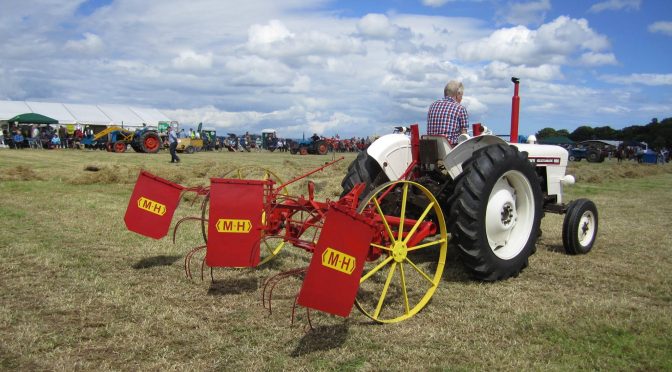What was it like to harvest the hay crop in Fife in olden days when the horse ruled and there was little machinery – no horse rakes, bogies, hay turners and the like?
The Board of Agriculture and Internal Improvement published the county agricultural surveys of agriculture for each county in Britain between 1794 and 1817. It includes accounts of agricultural activities, tools and implements. The following is an account of the hay harvest in Fife in 1800.
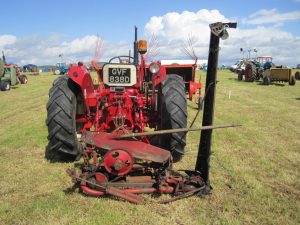 “Hay harvest begins in July, sooner or later, according as the season is more or less favourable. In hay making, two things are chiefly attended to;-first, the time of cutting; and, secondly, the hammer of winning or drying the hay. When the rye-grass is sown with a view to save the seed, as soon as it is fully ripe, it is cut and bound up in sheaves, dried in stocks, and put up in stacks like barley or oats. But if hay only be the object, it is cut down at least a fortnight before it be ripe, and while the seed is not yet in a state to be easily separated from the straw. Several advantages arise from this practice. The hay will be much superior in quality than when allowed to be fully ripe; will have a better flavour, and possess more of the natural juices. When completely ripened, before it be cut, the
“Hay harvest begins in July, sooner or later, according as the season is more or less favourable. In hay making, two things are chiefly attended to;-first, the time of cutting; and, secondly, the hammer of winning or drying the hay. When the rye-grass is sown with a view to save the seed, as soon as it is fully ripe, it is cut and bound up in sheaves, dried in stocks, and put up in stacks like barley or oats. But if hay only be the object, it is cut down at least a fortnight before it be ripe, and while the seed is not yet in a state to be easily separated from the straw. Several advantages arise from this practice. The hay will be much superior in quality than when allowed to be fully ripe; will have a better flavour, and possess more of the natural juices. When completely ripened, before it be cut, the 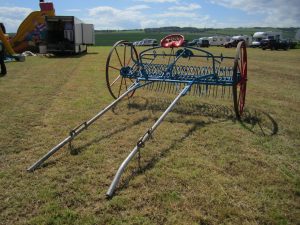 seed is apt to be mostly lost in the process of winning, stacking, cutting down again, and carrying to the rack or hay-loft. And this kind of grass, when fully ripe, and deprived of the seed, is a little superior to oat-straw. Another advantage is, that, by cutting before it be ripe, the ground will be less exhausted. When plants of any kind are allowed to run to seed, the leaves fall or wither; and the stem grows dry and hard, and consequently incapable of deriving any further nourishment from the air. The soil, therefore, being now obliged to supply the whole food necessary for maturing and perfecting the plants, must be greatly scourged and exhausted. This injury to the ground will be prevented by removing
seed is apt to be mostly lost in the process of winning, stacking, cutting down again, and carrying to the rack or hay-loft. And this kind of grass, when fully ripe, and deprived of the seed, is a little superior to oat-straw. Another advantage is, that, by cutting before it be ripe, the ground will be less exhausted. When plants of any kind are allowed to run to seed, the leaves fall or wither; and the stem grows dry and hard, and consequently incapable of deriving any further nourishment from the air. The soil, therefore, being now obliged to supply the whole food necessary for maturing and perfecting the plants, must be greatly scourged and exhausted. This injury to the ground will be prevented by removing 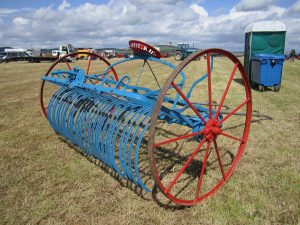 the crop before it be fully ripe. Another advantage, derived from early cutting, is, that the succeeding crop of clover will be more forward and more luxuriant, and the rye-grass, springing again, will render it more weighty and abundant. And, which is of no small consequence, if the whole second crop shall not be necessary for green food, more time will be allowed for making it into hay. Perhaps the best method of managing this, to make it rather more than half dry, and then mix it intimately with fresh old straw, and put it up into a stack. It will, in this state, make excellent winter food for cattle.
the crop before it be fully ripe. Another advantage, derived from early cutting, is, that the succeeding crop of clover will be more forward and more luxuriant, and the rye-grass, springing again, will render it more weighty and abundant. And, which is of no small consequence, if the whole second crop shall not be necessary for green food, more time will be allowed for making it into hay. Perhaps the best method of managing this, to make it rather more than half dry, and then mix it intimately with fresh old straw, and put it up into a stack. It will, in this state, make excellent winter food for cattle.
The mode of winning hay is not uniform; but is generally regulated by the kind and nature of the grass, and the state of the weather. 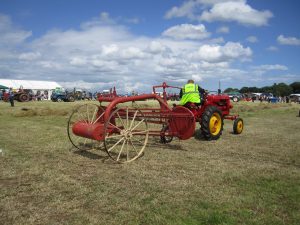 Sometimes hay from the seed, such as clover and rye-grass, is allowed to lye in the swathe for a few days after it is cut; and then, if the weather has been, and still continues to be dry, it is put into large cocks or tramp ricks in the field. Others, after allowing it to remain in the swathe for a short time, wither turn it over or spread it out on the morning of a dry day, and, on the afternoon, put it into large costs; after which, as soon as it is judged sufficiently dead, it to brought to the barn-yard and stacked. The former method requires less labour; and, therefore, when circumstances will permit, ought to be preferred. But should it meed with much rain in the swathe, and should it, at the same time, contain a large proportion of clover, it will be necessary, at all events, to spread it out. In such
Sometimes hay from the seed, such as clover and rye-grass, is allowed to lye in the swathe for a few days after it is cut; and then, if the weather has been, and still continues to be dry, it is put into large cocks or tramp ricks in the field. Others, after allowing it to remain in the swathe for a short time, wither turn it over or spread it out on the morning of a dry day, and, on the afternoon, put it into large costs; after which, as soon as it is judged sufficiently dead, it to brought to the barn-yard and stacked. The former method requires less labour; and, therefore, when circumstances will permit, ought to be preferred. But should it meed with much rain in the swathe, and should it, at the same time, contain a large proportion of clover, it will be necessary, at all events, to spread it out. In such 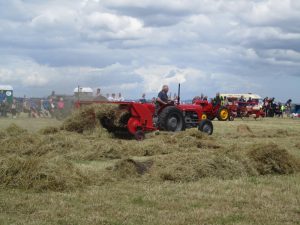 circumstances, should it be allowed to continue long in the swathe, it would come so close together, that the air could not easily penetrate it: It would become yellow, and lose its flavours before it could be dried. Repeated showers, or a long continuance of heavy rains, will do less harm to hay when spread, than when lying in the swathe, orin small cocks.
circumstances, should it be allowed to continue long in the swathe, it would come so close together, that the air could not easily penetrate it: It would become yellow, and lose its flavours before it could be dried. Repeated showers, or a long continuance of heavy rains, will do less harm to hay when spread, than when lying in the swathe, orin small cocks.
Natural grass, or meadow-hay, from its softness, and consequent closeness, when thrown off the scythe, will not admit of the same method of winning as rye-grass. The practice, therefore, is, to spread 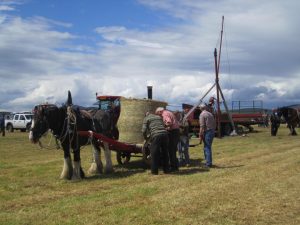 it soon after it is cut, and to turn it repeatedly at proper intervals. As soon as it is tolerably dry, it is put into cocks of a moderate size, which, if the weather continue favourable, are not spread out again, but turned over and increased in size, by putting two into ne; and then, when sufficiently dry, they are put together in tramp ricks, containing from 50 to 80 stones, neatly formed, and made fast with ropes, to secure them against the weather.
it soon after it is cut, and to turn it repeatedly at proper intervals. As soon as it is tolerably dry, it is put into cocks of a moderate size, which, if the weather continue favourable, are not spread out again, but turned over and increased in size, by putting two into ne; and then, when sufficiently dry, they are put together in tramp ricks, containing from 50 to 80 stones, neatly formed, and made fast with ropes, to secure them against the weather.
Heating in the stack, to a certain degree, is reckoned no advantage to hay, if this be occasioned by its own natural sap, but if by rain, the effect is otherwise.”
The photographs were taken at the Fife Vintage Agricultural Machinery Rally, June 2014.
